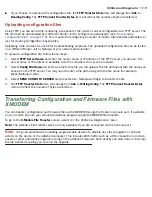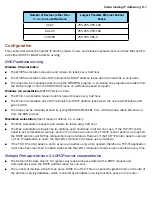
B-2 Firmware User Guide
IP addresses indicate both the identity of the network and the identity of the individual host on the network. The
number of bits used for the network number and the number of bits used for the host number can var y, as long
as cer tain rules are followed. The local network manager assigns IP host numbers to individual machines.
IP addresses are maintained and assigned by the InterNIC, a quasi-governmental organization now increasingly
under the auspices of private industr y.
Note:
It’s ver y common for an organization to obtain an IP address from a third par ty, usually an Internet
ser vice provider (ISP). ISPs usually issue an IP address when they are contracted to provide Internet access
ser vices.
The InterNIC (the NIC stands for Network Information Center) divides IP addresses into several classes.
Classes A, B, and C are assigned to organizations that request addresses. In Class A networks, the first byte of
an IP address is reser ved for the network por tion of the address. Class B networks reser ve the first two bytes
of an IP address for the network address. Class C networks reser ve the first three bytes of an IP address for the
network address. In all cases, a network manager can decide to use subnetting to assign even more bits to the
network por tion of the IP address, but never less than the class requires. The following section gives more
information on subnetting.
Class A networks have a small number of possible network numbers, but a large number of possible host
numbers. Conversely, Class C networks have a small number of possible host numbers, but a large number of
possible network numbers. Thus, the InterNIC assigns Class A addresses to large organizations that have ver y
large numbers of IP hosts, while smaller organizations, with fewer hosts, get Class B or Class C addresses. You
can tell the various classes apar t by the value of the first (or high-order) byte. Class A networks use values from
1 to 127, Class B networks use values from 128 to 191, and Class C networks use values from 192 to 223.
The following table summarizes some of the differences between Class A, B, and C networks.
Subnets and subnet masks
Often an entire organization is assigned only one IP network number. If the organization has several IP networks
connected together with IP routers, the network manager can use subnetting to distinguish between these
networks, even though they all use the same network number. Each physical network becomes a subnet with a
unique subnet number.
Class
First byte
Number of
networks
possible per
class
Number of
hosts
possible per
network
Format of address
(without subnetting)
Example
A
1–127
127
16,777,214
net.host.host.host
97.3.14.250
B
128–191
16,384
65,534
net.net.host.host
140.100.10.11
C
192–223
2,097,152
254
net.net.net.host
197.204.13.7
Содержание 4000 Series
Страница 10: ...x Firmware User Guide Packet header types B 14 Appendix C Binary Conversion Table C 1 Index ...
Страница 18: ...1 8 Firmware User Guide ...
Страница 66: ...2 48 Firmware User Guide ...
Страница 102: ...3 36 Firmware User Guide ...
Страница 130: ...4 28 Firmware User Guide ...
Страница 206: ...7 18 Firmware User Guide ...
Страница 224: ...9 14 Firmware User Guide ...
Страница 274: ...10 50 Firmware User Guide ...
Страница 314: ...Index 6 ...















































